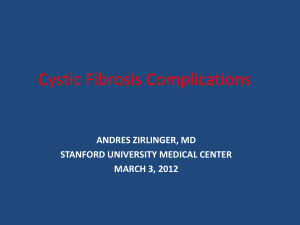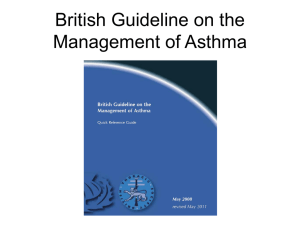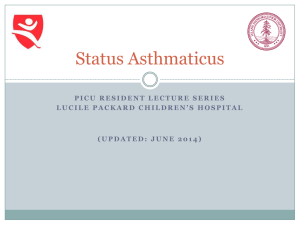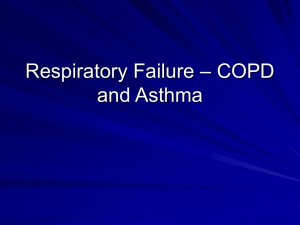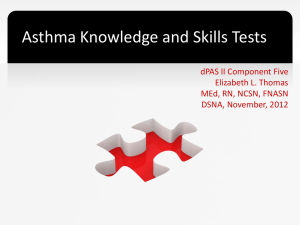肺部急症
advertisement
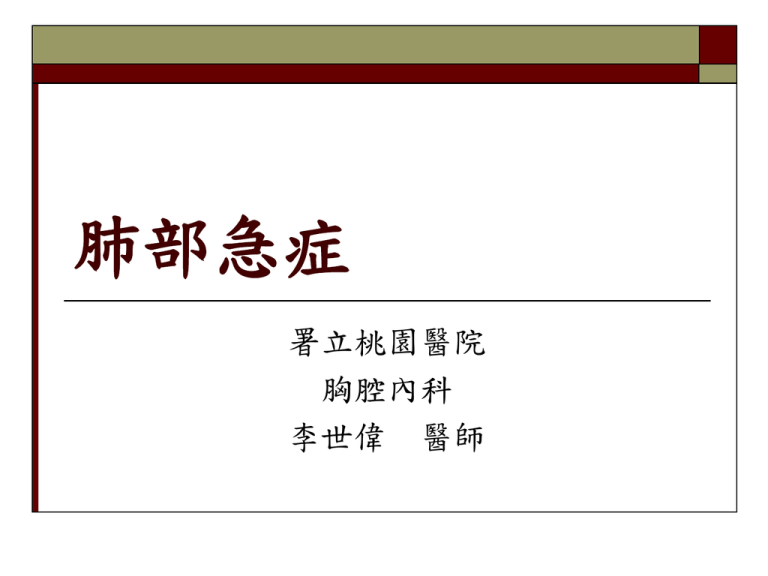
肺部急症 署立桃園醫院 胸腔內科 李世偉 醫師 前言 溺水(Near drowning) 煙霧吸入嗆傷(Smoke inhalation) 一氧化碳中毒(CO intoxication) 張力性氣胸(Tension pneumothorax) 大咳血(Massive hemoptysis) 氣喘(Asthma) 急性呼吸窘迫症候群(ARDS) 溺水(Near drowning) 煙霧吸入嗆傷(Smoke inhalation) 一氧化碳中毒(CO intoxication) 張力性氣胸(Tension pneumothorax) 大咳血(Massive hemoptysis) 氣喘(Asthma) 急性呼吸窘迫症候群(ARDS) 定義 溺死 ( drowning ):溺水後當場或24小時內死亡 溺水 ( near drowning ):溺水後存活超過24小 時 Submission:所有溺水者,不論預後好壞通稱之 濕溺 ( wet drowning ):溺水時,有明顯液體吸 入 乾溺 ( dry drowning ):溺水時,約有10%的人因 喉部反射使喉不緊閉,造成窒息,沒有吸入液體 病理生理學 缺氧 水分吸入:淡水及海水 淡水屬於低張力液體, 引起血容量增加,血液稀 釋,電解質濃度減少,紅血球融解造成高血鉀症. 海水屬於高張力液體, 引起血容量減少,血液濃 縮,電解質濃度增加,導致肺水腫. 喉部痙攣 繼發性溺水:約2-5%的溺水者,胸部X光可能為正 常,但在24小時後會發生遲發性的肺水腫,引起呼 吸窘迫症候群. 治療 心肺復甦術:越早做越好,要注意頸椎的保 護. 氧氣治療 人工呼吸器及PEEP 預防性的抗生素及類固醇並不一定需要,但 如有肺炎發生應給予抗生素治療. 預後 水溫 年齡 水的污染程度 心臟停止時間及開始心肺復甦術時間 溺水(Near drowning) 煙霧吸入嗆傷(Smoke inhalation) 一氧化碳中毒(CO intoxication) 張力性氣胸(Tension pneumothorax) 大咳血(Massive hemoptysis) 氣喘(Asthma) 急性呼吸窘迫症候群(ARDS) Pathophysiology Thermal injury Chemical injury Hypoxia Bronchiolitis obliterans organizing pneumonia caused by inhalation of oxides of nitrogen in a silo filler. Organizing pneumonia after sulfur dioxide intoxication. Diffuse alveolar damage caused by anhydrous ammonia inhalation. An agricultural worker inhaled the gas when a hose broke during the transfer of this fertilizing agent. Radiographic changes produced by diffuse alveolar damage. Chest radiograph of the same patient as in Figure 66-4 shows acute, diffuse alveolar and interstitial infiltrates. Treatment High concentration oxygen Bronchodilator Adequate fluid therapy Intubation if upper airway obstruction Ventilator with PEEP Antibiotics Prophylactic steroid is not necessary 溺水(Near drowning) 煙霧吸入嗆傷(Smoke inhalation) 一氧化碳中毒(CO intoxication) 張力性氣胸(Tension pneumothorax) 大咳血(Massive hemoptysis) 氣喘(Asthma) 急性呼吸窘迫症候群(ARDS) 一氧化碳中毒(CO intoxication)? Carbon Monoxide nonirritating, colorless, tasteless, and odorless gas incomplete combustion of carbon-containing material occurs in the setting of smoke inhalation, attempted suicide from automobile exhaust, and poorly ventilated burning charcoal or gas stoves Pathophysiology Carbon monoxide binds to hemoglobin with an affinity that is 240 times greater than oxygen and decreases oxyhemoglobin saturation and blood oxygen-carrying capacity. Its toxicity results from a combination of tissue hypoxia and direct inhibition of cellular respiration through cytochrome oxidase blockade. Clinical Manifestation The severity of carbon monoxide poisoning depends on the concentration of carbon monoxide, duration of exposure, and minute ventilation Carboxyhemoglobin concentrations up to 5% may result in headache and mild dyspnea. Carboxyhemoglobin concentrations between 10% and 30% cause headache, dizziness, weakness, dyspnea, irritability, nausea, and vomiting. Carboxyhemoglobin concentrations > 50% result in coma, seizures, cardiovascular collapse, and death. Diagnosis high index of suspicion for carbon monoxide poisoning Important historical clues can aid in the diagnosis. Carboxyhemoglobin levels are determined by COoximetry. Pulse oximetry cannot distinguish carboxyhemoglobin from oxyhemoglobin at the wavelengths that are commonly generated by standard pulse oximeters. Treatment The most essential treatment for carbon monoxide poisoning is oxygen Administration of 100% supplemental oxygen decreases the half-life of carboxyhemoglobin from 5 to 6 h on room air to 40 to 90 min. Hyperbaric oxygen (2.8 atmospheres within 6 h of exposure) further decreases the half-life of carboxyhemoglobin to 15 to 30 min. The role of hyperbaric oxygen in the management of carbon monoxide poisoning has been debated, and reviewed. Prognosis 10 to 30% of survivors acquire delayed neuropsychiatric sequelae (DNS). DNS has been described to occur from 3 to 240 days after apparent recovery. Its variable manifestations include persistent vegetative state, Parkinsonism, short-term memory loss, behavioral changes, hearing loss, incontinence, and psychosis. At 1 year, 50 to 75% of patients with DNS experience a full recovery. 溺水(Near drowning) 煙霧吸入嗆傷(Smoke inhalation) 一氧化碳中毒(CO intoxication) 張力性氣胸(Tension pneumothorax) 大咳血(Massive hemoptysis) 氣喘(Asthma) 急性呼吸窘迫症候群(ARDS) Bleb Bulla Pneumothorax Pneumothorax Pneumothorax Characteristics of pnx on supine film Pnx easily missed on supine films (32%) Features: Increased radiolucency at lung bases Sharp, elongated costophrenic/ cardiophrenic sulcus (deep sulcus) Depression of hemidiaphragm Flattening of heart border When to Suspect PNX in Ventilated Patients Clinical change in pt’s status Sudden or progressive increase in PIP Hypotension or cardiovascular collapse Sudden onset of agitation and resp distress (fighting the ventilator) CXR findings General increase in volume or increase in relative radiolucency of hemithorax Deep sulcus sign Risk Factors for Alveolar Rupture During MV Right main bronchus intubation High peak inflation volume Excessive tidal volume Excessive PEEP Auto-PEEP Obstructive lung diseases (COPD, Asthma) Heterogeneous lung disease Nosocomial pneumonia Late phase of ARDS Steps to Reduce Alveolar Rupture During MV Use small TV Decrease TV as PEEP increases Use PEEP cautiously in high risk pt Avoid right main bronchus intubation Monitor for auto-PEEP High inspiratory flowrate with low I:E ratio Bronchodilator if bronchospasm is present Reduce minute ventilation Chest decompression 溺水(Near drowning) 煙霧吸入嗆傷(Smoke inhalation) 一氧化碳中毒(CO intoxication) 張力性氣胸(Tension pneumothorax) 大咳血(Massive hemoptysis) 氣喘(Asthma) 急性呼吸窘迫症候群(ARDS) Life-threatening hemoptysis According to Coss-Bu et al., major hemoptysis comprises large and massive bleeding, which correspond to blood expectoration of 150-400 mL per day and to more than 400 mL per day, respectively. Other definitions of massive hemoptysis range from 400 to 1000 mL per day Regardless of the exact amount of blood loss for each category of major hemoptysis, large and massive hemoptysis are both life-threatening. 一看就知道他們做過什麼事 Bronchoscopy Massive hemoptysis Left, A: prominent areas of tissue enhancement are seen to be consistent with intense inflammation and hypervascularity (arrows) Swanson, K. L. et al. Chest 2002;121:789-795 Massive hemoptysis 還沒結束, 別走啊! 溺水(Near drowning) 煙霧吸入嗆傷(Smoke inhalation) 一氧化碳中毒(CO intoxication) 張力性氣胸(Tension pneumothorax) 大咳血(Massive hemoptysis) 氣喘(Asthma) 急性呼吸窘迫症候群(ARDS) The best way to manage the fatal asthma The best strategy for management of acute exacerbations of asthma is early recognition and intervention, before attacks become severe and potentially life-threatening. Detailed study into the circumstances surrounding fatal asthma have frequently revealed failures on the part of both patients and physicians to recognize the severity of the disease and to intensify treatment appropriately . Peak flow measurement for assessment of attack severity Measurement of the severity of airflow obstruction with a peak flow meter in the home and in the medical office helps to avoid such mistakes. A fall to less than 50 percent of baseline should be considered a severe attack. A peak flow rate below 200 L/min indicates severe obstruction for all but unusually small adults . Other assessment method: S / S ARF in asthma In the asthmatic patient with a severe acute attack (status asthmaticus), intensive medical therapy is usually sufficient to improve the symptoms. However, therapy is not invariably effective in time to avert respiratory failure. It is critically important to recognize deterioration promptly, as respiratory failure can develop very rapidly. This may occur in part because of the narcotizing effect of hypercapnia on patients already fatigued from the enormous increase in the work of breathing. Preventing intubation Intubation and MV may be associated with significant morbidity and mortality, it is desirable to avoid intubation whenever possible. Pharmacotherapy. Heliox therapy; NPPV therapy: buy time for medical therapy to work. Indications and principles of intubation The decision to proceed is best based on an integrative clinical assessment of the patient's ability to continue ventilation until therapy becomes effective. Worsening fatigue and persistent or increasing hypercapnia weigh heavily in favor of intubation. Asthmatics have exaggerated bronchial responsiveness, and inutbation is difficult in any circumstance, particularly under the conditions of hypoxia, hypercapnia, and acidosis of respiratory failure. The decision to proceed to intubation &MV should be made before respiratory arrest. Indications for intubation and MV in status asthmaticus Respiratory or cardiac arrest: must be avoided. General appearance of the patient: change in mental status, posture, speech, diaphoresis, extent of accessory muscle use, RR….(most important) (patients deteriorating on these grounds ) Increasing pulsus paradoxus Decreasing pulsus paradoxus (exhausted pt) Acute barotrauma Severe lactic acidosis (esp in infants) Silent chest despite respiratory effort Refractory hypoxemia ( PaO2<60 mmHg on maximal O2) *considered the other s/s. Increasing PaCO2 (50mmHg&rising>5mmHg/hr) * considered the other s/s. The principles of intubation To achieve prompt, complete sedation, often by infusion of repeated doses of one to two mg of midazolam at two minute intervals. To use a large endotracheal tube to minimize added resistive load and to facilitate suctioning of secretions. To be prepared to infuse large volumes of crystalloid should hypotension result from the abrupt shift in intrathoracic pressures. Sedation and paralysis Even after sedation and intubation, some patients are unable to breathe in synchrony with the ventilator, especially when it is set to avoid high peak inspiratory pressures . Paralytic agents may be necessary in this setting. Both vecuronium and atracurium are safe and effective in the short term. Use them just after ensuring adequate sedation . If used over several days, paralytic agents may contribute to the development of an acute, diffuse myopathy. The resulting muscle weakness can be profound, and recovery may require many months of rehabilitation and even then may be incomplete. Postintubation hypotension Incidence: 30% Reasons: 1. Loss of vascular tone and sympathetic activity due to sedation. 2. Hypovolemia. 3. Over Ambu bag ventilation result in severe dynamic hyperinflation (DHI) Severe DHI occurs, the pt becomes difficult to ventilate, breath sounds diminish, BP falls, and HR rises. A trial of hypopnea or apnea is diagnostic and therapeutic for DHI-induced hypotension. Mechanical ventilation (MV) Until recently, barotrauma was a common complication of the high pressures required to maintain normal alveolar ventilation in patients with asthma. Surveys of outcomes in patients requiring mechanical ventilation prior to 1990 showed mortality rates as high as 38 percent, with many deaths resulting from pneumothorax and ventilator malfunction . The history of MV in obstructive airways disease Conventional MV for acute asthma has been associated with a mortality in excess of 20 %, owing to a significant incidence of barotrauma . A strategy of permissive hypercapnia ventilation (PHV) was first reported in 1983. No deaths were reported in 26 asthmatics who received MV at tidal volumes of 8 to 12 mL/kg and low respiratory rates (6 to 10 /min; peak inspiratory pressures were kept under 50 cmH2O. To maintain a low peak airway pressure, respiratory drive was suppressed as needed with diazepam and/or pancuronium, and inspiratory flow rates were at times decreased. Recent change in ventilator strategy Recent sharp reduction in mortality in this setting was the realization that, as long as arterial oxygenation is adequate, the risks of hypercapnia are far smaller than the risks of excessively high inspiratory pressures . The key element to this approach, referred to as permissive hypercapnia ventilation (PHV), is to set the ventilator to deliver tidal volumes small enough and at a frequency slow enough to keep plateau pressure under 30 cmH2O. This regimen is continued as long as necessary providing oxygenation can be maintained and the PaCO2 does not rise above 90 mmHg. Measuring dynamic hyperinflation A measure of lung hyperinflation has been used to regulate levels of MV. This measurement consists of collecting all the exhaled gas from paralyzed, ventilated patients after 40 to 60 seconds of apnea. This volume is termed "end-inspiratory lung volume above FRC" (VEI). Most barotrauma and hypotension complications of ventilation are avoided when VEI is maintained below 20 mL/kg. The ventilator settings are adjusted to achieve this goal, mostly by keeping minute ventilation below 115 mL/kg/min. Another approach to monitoring and minimizing hyperinflation by keeping Pplat < 30 cmH2O can decrease complications.(check Pplat with a single breath only) Mechanical ventilation: initial settings Mode : pharmacologically controlled; A/C; or SIMV. FiO2 : 1.0 or sufficient to keep PaO2 ≧ 60 mmHg. Tidal volume : 8 mL/kg & Pplateau <30 cmH2O. Respiratory rate : ≦ 8 /min; allow permissive hypercapnia (PH>7.1~7.2) Ti : ≦1 s, keep short to avoid auto-PEEP. I:E ratio : 1:3 to 1:5. Inspiratory flow rates : ≧ 60 L/min. Inspiratory wave form : decelerating/ square wave. PEEP: increase to 80% of auto-PEEP with caution during spontaneous breathing. (in controlled mode?) Volume/ pressure target : Pressure or volume. General approach to obstructive airways disease In general, we adhere to the low tidal volume, low minute ventilation approach outlined above and strive to maintain plateau airway pressures below 30 cmH2O, irrespective of the level of hypercapnia encountered. (adequate sedation). The use of PHV for obstructive airways disease should target minimizing pulmonary hyperinflation, not avoiding an arbitrary level of peak airway pressure. Slow inspiratory flows are best avoided, irrespective of their effect on peak airway pressure. Monitoring for asthma pt with MV Plateau airway pressure ≦ 30 cmH2O. Peak airway pressure ≦ 45 cmH2O. Mean airway pressure ≦ 25 cmH2O. Auto-PEEP. Presence of barotrauma. Pulse oximetry & arterial blood gases. Heart rate and blood pressure. WEANING FROM VENTILATORY SUPPORT It is of utmost importance to discontinue ventilator support as soon as possible. Intubation itself provides an ongoing irritant stimulus and can cause bronchoconstriction. Do not wean the asthmatic pt; discontinue ventilatory support when the volumes & pressures have markedly improved, and clinically pt is alert, oriented, and cooperative. Most pt can discontinue the ventilator within 48 hours. 溺水(Near drowning) 煙霧吸入嗆傷(Smoke inhalation) 一氧化碳中毒(CO intoxication) 張力性氣胸(Tension pneumothorax) 大咳血(Massive hemoptysis) 氣喘(Asthma) 急性呼吸窘迫症候群(ARDS) 我不行了! THANK FOR YOUR ATTENTION

